Today we will be looking at the Page Layout Tab in Microsoft Excel 2007. This Tab has many new features that will let you change the look and feel of your Excel workbook. The Page Layout Tab is divided into the following groups: - Themes Group
- Page Setup Group
- Scale to Fit Group
- Sheet Options Group
- Arrange Group
Here is a screen shot of the Page Layout Tab in Microsoft Excel 2007. |
 |
Themes Group:The first group that we will look at is the Themes group. Themes in Microsoft Excel provide a unique and professional look to your Workbooks. They can do this by using an assortment of font styles, color schemes and graphical effects.
We will use a customer list workbook for our lesson today. I have included a screen shot of our data in the figure below. We have some basic information on our customers like first names, last names, addresses and the phone numbers. Notice that we do not have any formatting applied to it yet and it looks rather plain and simple.
Before you can use Themes, you need to apply a little formatting to some of your data elements. In our case, we would like to use a Title and also emphasize or Column Headings. We also need to change the row height to 30 pixels to accommodate the bigger Title. We can do that by clicking on row header of the first row. Then we browse onto the Home Tab in Excel 2007 and choose Cell Styles command in the Styles group. We would like to change the textCustomer Master List to Heading 1.
The specific steps are highlighted below in the screen shot. |
 |
Moving onto the column headings, we need to make them prominent as well. We will again use Cell Styles command from the Home Tab and then select custom formatting style something like Good .
The last action and its effect is illustrated in the figure below. |
 |
Now we are finally ready to experiment with Themes in Microsoft Excel 2008. I have moved your title Customer Master List to cell D1 so it is positioned in the center.
Using the Page Layout Tab, click on Themes drop down in the Themes group. You will get a host of built-in, pre-defined and ready made available Themes. Notice as you browse from one option to another, Microsoft Excel will not only change the underlying format but also give you a live preview of the end result, Very Nice Indeed!
We will go ahead and choose Opulent for our theme choice. Here is what this step looks like. |
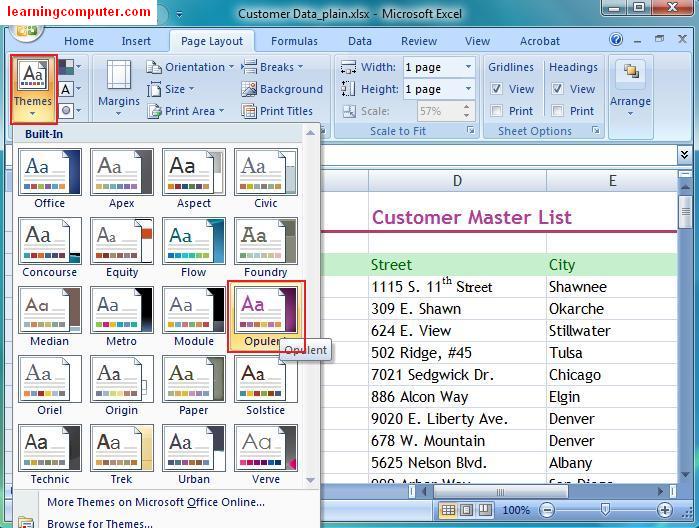 |
If you are not happy with the color scheme, you can certainly use one of the many available Theme Colors from the Themes Group. For our customer list, we would like to use maybe Equity since this color scheme is more professional looking.
Notice below that using the Theme Colors will not affect the font style, just the font color. |
 |
The last option we'll cover in the Themes group is to use one of the Theme Fonts from the drop down list. We would like to emphasize the Title and Heading elements a little more in our customer list. Using the Theme Font functionality, we can possibly choose Office Classic 2.
As we hover the mouse over the Theme Fonts, we get a Live Preview of its effect on our Worksheet. |
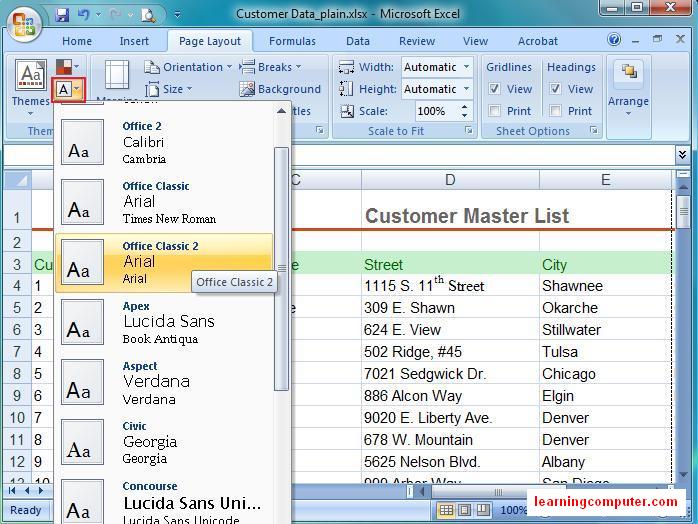 |
The final version of our document is shown below. I have changed the Zoom Level to 66% so you can see the data a bit better and also to include all the data columns.
Here is the screen capture. Notice the dotted line after column E, this is where is Excel workbook will be split into two pages when printed. |
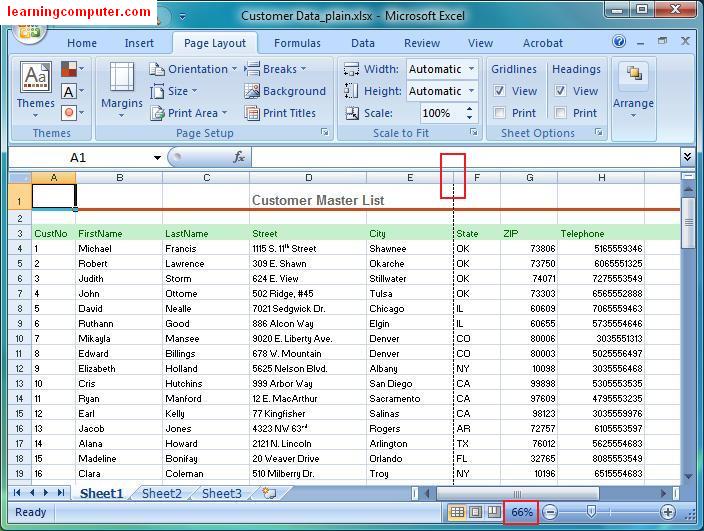 |
Page Setup group: Moving onto the next group, here we have many different choices for our Microsoft Excel worksheet layout. Let us take a look at these one at a time.
First of all I would like to change your view from Normal to Page Layout so I can see the effect of your Page Setup choices clearly. I can do this by selecting the View Tab on the Ribbon and then choosing Page Layout option.
The command and its effect are shown below. The Page Layout shows us the worksheet in its printed form which was sometimes a challenge in the past. We can now see the margins on all sides, the header block and all the column headings that will be included in the first page. |
 |
The first Page Setup option is Margins, which lets you control the white space in your document. We would like to switch margins in the worksheet from Normal to Narrow so we can see more of customer data when we print this file. Go ahead and click on Margins command and then select Narrow from the drop down menu.
This action is highlighted below from your computer monitor. |
 |
You will see that there is less space on the right and left sides of your worksheet now. As a result of this, now we can even see the State column on your first page as shown below, Cool! |
 |
The next command is Orientation under the Page Setup Tab in Microsoft Excel 2008. This will let you toggle between Portrait and Landscape views for printing purposes.
Currently we are using Portrait view. Lets us switch it to Landscape view by clicking on Orientation drop down and then choosing Landscape. After this action, you will be able to see all the columns in your Excel Sheet. Go ahead and click Save icon on Quick Access Toolbar. The next two screen capture hight light the effect of using Landscape Orientation. |
 |
 |
You can further fine tune some of the print settings also. You can either use the Page Setup button either from the Print Preview screen or by using Dialog box launcher button (small red square) in the bottom right corner of Page Setup group on Page Layout Tab,
Here is a screen shot of the Page Setup dialog box. For now I am going to switch back to Portrait and then click Ok. |
 |
|
Using the Size command is pretty handy if you need to do some specialized paper printing. Let's assume that you would like to print customer data to a legal format as opposed to a letter format. You can easily do this by selecting Size command and then choosing an Legal from the list.
The screen capture below highlights this change in Paper size. |
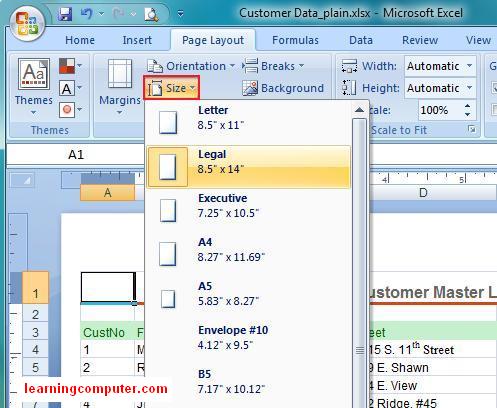 |
What if you wanted to insert a page break lets say after the first 20 customers? You can easily do this by moving your mouse to the 21st customer, clicking on Breaks command and then choosing Insert Page Break.
Here's the illustration of the necessary steps. |
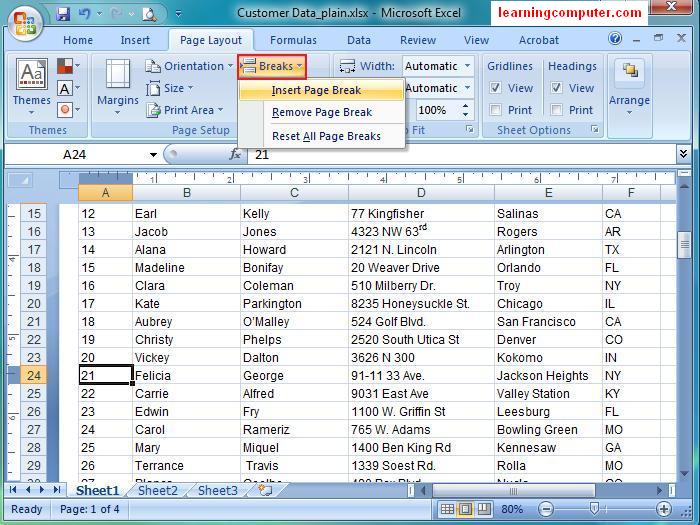 |
The next command is Background on the Page Setup Tab and it will let you add a background image to your Excel workbook. This could be beneficial if you are trying to insert possibly the company logo with your data. When you click on this command, it will give you a new dialog box where you can select the picture and then click OK. We will proceed onto the next feature.
The Print Titles command is quite essential when you are trying to print a lot of information that spans multiple pages. This scenario does apply to our current customer list as it spans over four pages.
Before we try this option, let us do you a Print Preview using the Office button. When I did this, notice the first page has all the column headings, however they are missing from the second page, definitely not good!
This is visible in the screen shot right below. |
 |
You can easily fix this problem by using the Print Titles command. When you click on this command, you get the Page Setup dialog box we have already seen before.
Go ahead and select the icon under Rows to repeat at top. Here is the associated screen shot. |
 |
Next browse back to the first row (3) and select all the row headers. This will insert the necessary information in the Page Setup dialog box. Go ahead and click OK. We have included the related screen capture. |
 |
| Now when you do a final Print Preview, the column headings do show up on the subsequent pages, very nice indeed. The the column headings on the second page are shown below. |
 |
|
Scale to Fit Group: For the next set of exercises that switch back to the portrait view. When we did that notice that the column Headings after City are now spanning over to the next page on the right. How can we fix this?
We can take care of this by using the Scale to Fit group. Under the Width command, click on the drop down and select 1 page. |
 |
Now when I do Print Preview, it adjusted the formatting so that all the columns fit onto one page as shown below, Sweet! |
 |
In a similar fashion, you can also control the height of your Excel Sheet. Under the Height command, you can select 1 page option. This will change the formatting scale of your data to fit it on 1 page.
When I did a Print Preview again, now the customer data is looking rather small. I will then switch it back to 2 pages for the Height, as illustrated below. |
 |
When we did a final Print Preview, everything look great. If you notice on the bottom left corner in the Status Bar, we have now shrunk the data to 2 pages instead of 4. Let us go ahead and save the file now. |
 |
Sheet Options Group:
The next group we will go over is Sheet Options. We have two properties that we can control here, Gridlines and Headings. Currently they both are checked and this is also shown in the Microsoft Excel sheet below. |
 |
First let us see the effect of removing Gridlines. You can simply uncheck the View box under the Gridlines menu. This will yield a much cleaner format of your data as the gridlines have been removed.
Here is what it looks like. |
 |
In the second step, you can go ahead and uncheck the View box under Headings Menu. Notice that it removed both the row and column headings after this action. This also gives you more real estate and shows a little more of your datasheet than before.
Here is a screen capture of removing the Headings. |
 |
Arrange Group:
The last group in the Page Layout Tab is Arrange. This is primary used with pictures or images. Once you have such an element in your workbook, you can then use Arrange commands to position the item relative to your data. For now we will skip over this and come back to it when we go over the Insert Tab.
This web content is being used by permission from http://www.learningcomputer.com.
This concludes the tutorial on Page Layout Tab in Microsoft Excel 2007. |

0 comments:
Post a Comment